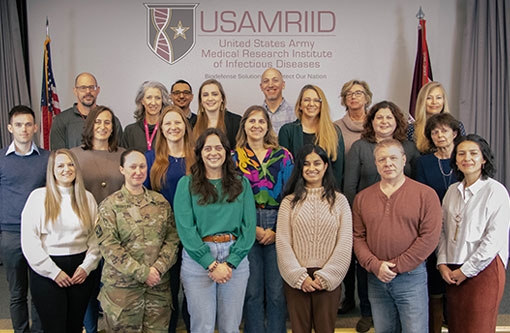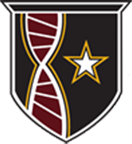Teamwork Key to Success for Army Lab's 2022 Employee of the Year

For Andrew Herbert, Ph.D., winning the 2022 Employee of the Year award at the U.S. Army Medical Research Institute of Infectious Diseases was a team effort.
"The best part of science is collaborating with people who are smarter than you, to accomplish more than you ever could on your own," said Herbert, who is chief of the Viral Immunology Branch at USAMRIID. The group has developed therapeutics for Ebola virus, SARS-CoV-2, and other infectious disease threats to military and global health.
In September 2022, the World Health Organization declared a significant outbreak of Sudan Ebola Virus (SUDV) in Uganda, with 142 confirmed cases and 55 confirmed deaths. The Viral Immunology Branch was already collaborating with drug company Mapp Biopharmaceuticals to develop an antibody therapy to treat Ebola virus infections.
That product, known as MBP134, was the first experimental treatment shown to protect animal models against SUDV and the two other types of Ebola virus known to cause human disease, according to USAMRIID studies published in 2019. During last year's outbreak, the United States dispatched MBP134 to Ebola Treatment Units in Uganda for compassionate use in patients. It is currently the only SUDV-specific treatment available in country, and clinical trials are underway, according to the WHO.
Over the past several years, USAMRIID's Viral Immunology Branch has established relationships that allow them to work with multiple international collaborators and government agencies to access blood samples collected from disease outbreak survivors around the world. They use these samples to develop treatments based on protective antibodies, which are proteins found in the blood that have been produced by the human immune system in response to a viral infection. MBP134 is a cocktail of two protective antibodies isolated from survivors of Ebola virus.
"When you're exposed to a virus, your immune system responds, and part of that response is to generate B-cells that recognize the virus," said Herbert. "Our goal is to identify individual virus-specific B-cells that make antibodies capable of neutralizing the virus really well, so that we can slow the virus down and interrupt the course of disease."
Using a therapeutic discovery platform pioneered at USAMRIID, the team first conducts the studies needed to identify which antibodies contributed to patient survival. Additional work can then be done to determine their safety and efficacy as a treatment, and to manufacture these protective antibody treatments at commercial quantity and grade to make them available to patients. Importantly, this platform is being used to discover protective antibodies to a wide array of viruses of concern to the Warfighter and public health.
In the past year alone, the Viral Immunology Branch has managed 19 research programs and published eight articles in some of the world's top peer-reviewed scientific journals. Notable among them was a March 2022 paper in Science Translational Medicine detailing the research that led to the Food and Drug Administration's emergency use authorization of the drug EVUSHELD, an antibody therapy that protected against COVID-19 variants circulating in the U.S. at that time. The study was conducted in collaboration with industry partner AstraZeneca.
Also in March of last year, the group published a second article in Science Translational Medicine describing the first antibody therapy to demonstrate efficacy in animal models against both "Old World" and "New World" hantaviruses–pathogens of concern to military and civilian populations in Asia, Europe, and the Americas. This antibody, developed in collaboration with Prometheus, a consortium of U.S. and international academic and industry partners, is currently being pursued by both the Department of Defense and the National Institutes of Health as a potential therapeutic option for patients suffering from hantavirus infection.
Herbert represented USAMRIID as an invited guest speaker at multiple national and international scientific meetings in 2022. In addition, the team accomplished several field missions to expand the reach of their therapeutic discovery platform.
In April and August 2022, members of the Viral Immunology Branch traveled to Uganda to collect samples from survivors of Marburg virus and Crimean Congo hemorrhagic fever virus infections, in partnership with the Ugandan Virus Research Institute in Entebbe. In May and November, the group visited Tbilisi, Georgia, on a similar mission focused on CCHF and hantavirus therapeutic development, working closely with the National Center for Disease Control and Public Health. In July and November, team members traveled to Panama to work with partners at the Gorgas Institute, collecting samples from survivors of Venezuelan equine encephalitis virus. And in April, the group visited Bolivia to collect samples from Machupo virus survivors, in collaboration with researchers from the Templar Corporation.
These efforts directly support the development of treatment options for Service members stationed or deployed around the world. What makes the work especially challenging, according to Herbert, is that while most of the high-consequence viral agents studied at USAMRIID have no approved vaccines or therapeutics, there is also little financial incentive for drug companies to invest in such products given their limited potential market. The lack of commercially available off-the-shelf products for these viruses puts Warfighters at risk should they deploy to an endemic area–or be deliberately exposed to a biological agent by an adversary.
"Dr. Herbert has deftly navigated complex relationships with multiple international collaborators to address these emerging biological threats," said Col. Constance Jenkins, USAMRIID's commander. "His team's efforts have advanced the science of medical countermeasure development to benefit the Warfighter, U.S. public health, and the global community at large."
Herbert is quick to point out the importance of collaboration in all his accomplishments. Working on therapies and identifying antibodies isn't done in a single lab or by any one individual, he says. About 20 USAMRIID researchers are involved, including five other Ph.D. scientists in the Viral Immunology Branch, each of whom leads a portion of the many research programs ongoing at any given time. In addition, active agreements with government, industry, and academic partners leverage the latest cutting-edge science and technology to complement the work at USAMRIID.
With 2023 well underway, Herbert says the team is focused on continuing to find innovative ways to address gaps in the DoD's medical countermeasure toolbox through teamwork and research partnerships, both internally at USAMRIID and with external partners around the world.
"There are very few places where a virologist can do what we do here at USAMRIID," he said. "We are in a unique position to open our doors in a collaborative way to some of the most brilliant and talented people in our field, and I'm lucky enough to work side by side with some of them every day. Collaborative relationships have been so instrumental to the successes our group has experienced, not just in 2022 but over the past decade, and those relationships are–without question–one of the most rewarding aspects of my job."
[Additional reporting by Joseph Nieves]













